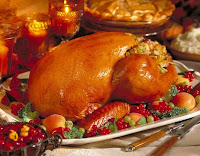What is Thanksgiving?
 An English woman asked me this simple enough question today. Thanksgiving is the biggest American family holiday. It takes place on the last Thursday of November and is also the biggest air travel date in the US. As a family holiday, it is associated with all the things people usually conjure up when they think of family obligations, and people they only see once a year, with whom they may or may not get on well. My favorite movie about Thanksgiving and the modern American family is Home for the Holidays starring Holly Hunter.
An English woman asked me this simple enough question today. Thanksgiving is the biggest American family holiday. It takes place on the last Thursday of November and is also the biggest air travel date in the US. As a family holiday, it is associated with all the things people usually conjure up when they think of family obligations, and people they only see once a year, with whom they may or may not get on well. My favorite movie about Thanksgiving and the modern American family is Home for the Holidays starring Holly Hunter. In grade school, American children dress up as Pilgrims and Indians and are taught how the Pilgrims escaped religious persecution in England and gave thanks for their very first successful harvest in the New World, with a celebratory feast to which they invited their new friends, the Indians. Of course some of these escapees of religious persecution didn’t turn out to be the most tolerant people themselves. Then perhaps the Indians weren’t thankful when we later killed them and took their land, but only kill-joys bring that stuff up.
Thanksgiving also comes with various required dishes that many Americans hate, but prepare anyway because otherwise it wouldn’t feel like Thanksgiving—the chief ones are turkey, sweet potatoes, wild rice, cranberries and pumpkin pie. Depending on your individual tastes, the recipes you select, and your cooking ability, these dishes can either be mouth-watering or stomach-churning. In my case, having a Mother Who Could Cook turned me into the worst of both worlds--a judgmental eater, who never bothered to learn any of the basic holiday dishes because there was always somebody there willing and happy to cook them for me and everybody else.
Since I will be away from home and want to cook my own Thanksgiving dinner, my good friend has suggested I go to the Butterball website, which even has a turkey hotline. Whenever, I despair of my country, I am comforted to see this return to our roots and thoughtful marketing, aimed at me, the consumer. The Butterball website dispenses useful information like how long to bake your turkey based on its weight, how big a turkey you should get based on the number of people you are inviting and a recipe selection that caters to the two Americas—those whose lofty and unachievable ideals that lead them to attempt a demi-glace once a year, and those who happily grab the bouillon cube and water; those make their own pie crusts and those who grab the ready-made variety off the freezer shelf at the grocery store. In the US, there’s even a new option for centrists—the roll-out circle of pie crust that you can feel good about pressing into your pan, sometimes it’s even made with real butter.
A family member who once worked in Unilever’s baby foods division described the middle-ground consumer as the Holy Grail of Marketing. I asked her what Unilever thought about women like me who breast-fed for a year and made their own baby food? She said: “We don’t even bother to try and market to people like you. Our ideal consumer is the guilt-ridden mother who is willing to pay more to give her baby healthier off-the-shelf options.” After four children, whom I duly breastfed and made healthy home-made purees for, that woman is me! I’m glad to learn that I matter, that someone cares. Thank you for giving me those choices Butterball!
By the way, it was once brought to my attention in blog comments, some of you are offended by the fact I and other citizens of the US call ourselves Americans. Yes, some of us are aware that we are only one country in the continent of North America. However, if you can’t find any grossly more offensive use of imperialist, Euro-centric, US-centric linguistic manipulation to focus on, shame on you. Please devote your energies to finding and marketing a better alternative, preferably identifying with the struggle of indigenous native peoples…and not a16th century Italian mapmaker.


Comments